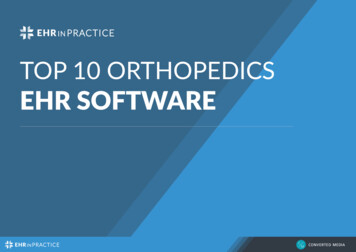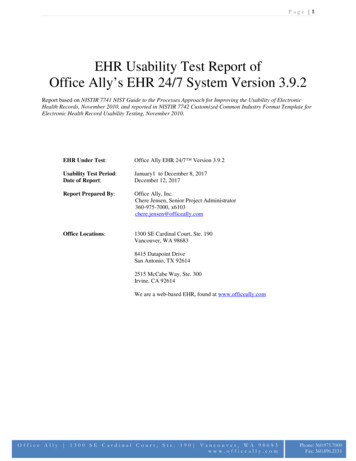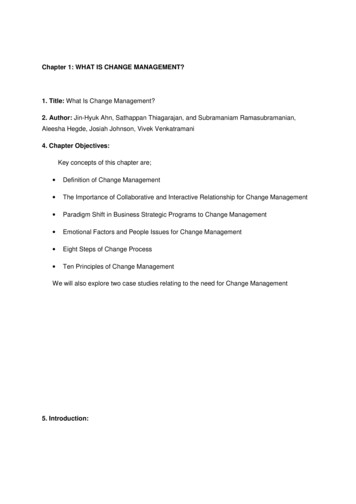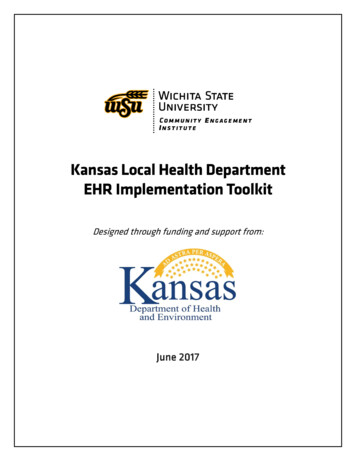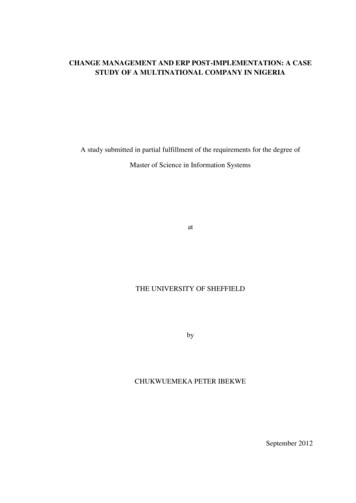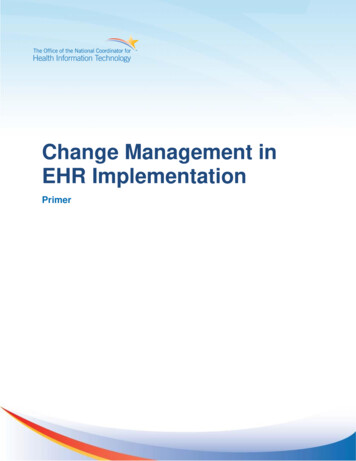
Transcription
Change Management inEHR ImplementationPrimerJune 2016 Version 2.0
The following resource can be used in support of the EHR Implementation Lifecycle. It is recommendedby “boots-on-the-ground” professionals for use by others who have made the commitment to implementor upgrade to certified electronic health record (EHR) systems.EHR Implementation LifecycleDescription and InstructionsThis primer is intended to aid providers and health information technology (health IT) implementers withchange management for EHR implementation. Change management is the basic foundation underlyingall phases of the EHR Implementation Lifecycle and helps achieve EHR Meaningful Use and practicetransformation. The EHR Implementation Lifecycle shows the phases a practice goes through in asuccessful implementation.Change management strategies and principles must be integrated into all phases of the implementationprocess. This change management primer synthesizes the strategies and principles proposed by JohnKotter, one of the leading experts in planning organizational change using a structured changemanagement approach.This resource includes the following sections: Section 1 introduces the basic change management principles and explains why managing anychange effectively is important to the success of EHR implementation and other practicetransformation initiatives. Section 2 provides more detail on implementing Kotter’s principles in practice settings that arefocused on managing specific organizational changes commonly seen in practices today. Thediscussion focuses on ways to help practice leaders optimize the use of health IT to move theirpractice to a desired Future State. Section 3 provides a summary of critical success factors and the management interventions thatmust occur to achieve success with change initiatives and some “must do” steps to effectivelymanage change. Section 4 provides additional resources related to change management.June 2016 Version 2.0ii
TABLE OF CONTENTS1What Is Change Management and Why Is It Important? . 11.1 Introduction . 11.1.1 Phase 1: Creating a Climate for Change . 21.1.2 Phase 2: Engaging and Enabling the Organization . 31.1.3 Phase 3: Implementing and Sustaining the Changes . 31.2 How Will Change Impact People, Processes, and Technology? . 41.2.1 Changing How People Work . 41.2.2 Changing Processes . 51.2.3 Changing the Technology . 52What Steps Do I Need to Take to Get Started? . 62.1 Paper to EHR . 62.1.1 Action Steps for Phase 1: Creating a Climate for Change . 62.1.2 Action Steps for Phase 2: Engaging and Enabling the Organization . 72.1.3 Action Steps for Phase 3: Implementing and Sustaining the Changes . 72.2 Achieving to Meaningful Use—Patient Engagement . 92.2.1 Action Steps for Phase 1: Creating a Climate for Change . 92.2.2 Action Steps for Phase 2: Engaging and Enabling the Organization . 92.2.3 Action Steps for Phase 3: Implementing and Sustaining the Changes . 102.3 Replacing an Existing EHR . 122.3.1 Action Steps for Phase 1: Creating a Climate for Change . 122.3.2 Action Steps for Phase 2: Engaging and Enabling the Organization . 122.3.3 Action Steps for Phase 2: Implementing and Sustaining the Changes . 122.4 New Models of Care: Patient-Centered Medical Home (PCMH) and AlternativePayment Models (APMs) . 152.4.1 Action Steps for Phase 1: Creating a Climate for Change . 152.4.2 Action Steps for Phase 2: Engaging and Enabling the Organization . 162.4.3 Action Steps for Phase 3: Implementing and Sustaining the Changes . 163Measuring the Effectiveness of Your Change Management Strategies to EnhanceSuccess . 184Resources . 21June 2016 Version 2.0iii
LIST OF EXHIBITSExhibit 1: Kotter's Three-Phased Approach to Managing Change . 1Exhibit 2: Overview of the Three Phases of Kotter’s Change Management Principles and Related Actionsfor Paper to EHR. 8Exhibit 3: Overview of the Three Phases of Kotter’s Change Management Model and Related Actions forMeaningful Use Achievement . 11Exhibit 4: Overview of the Three Phases of Kotter’s Change Management Model and Related Actions forUpgrade/Rip and Replace . 14Exhibit 5: Care Coordination and Health IT . 15Exhibit 6: Overview of the Three Phases of Kotter’s Change Management Model and Related Actions forAlternative Payment Models (APMs) . 17Exhibit 7: Managing Change Through Active Practice Leader Intervention . 18Exhibit 8: Critical Success Factors and Management Interventions for Managing Change . 19June 2016 Version 2.0iv
1What Is Change Management and Why Is ItImportant?1.1IntroductionChange management is “the application of the set of tools, processes, skills, and principles for managingthe people side of change to achieve the required outcomes of a change project or initiative.”The Change Management Learning CenterChange in health care is moving at a rapid pace as practices strive to implement regulatory and policyrequirements, such as ICD10; understand new models of care such as patient-centered medical homes(PCMHs); and continue their own quality improvement efforts. Many practices are doing all of this whileimplementing a certified electronic health record technology (CEHRT) to achieve Meaningful Use. Thischange is happening at a time when providers are still seeing patients and trying to maintain a healthywork–life balance.These are clearly stressful times for providers and their staff, and adapting to change has become a wayof life for their practices. Fortunately, change management is a well-developed field with significantevidence and leading practices on how to successfully navigate the change process. One of the leadingthinkers in planning organizational change and providing practical strategies for navigating change isJohn Kotter.Kotter believes that any change has both emotional and situational components, and he has proposed amultistep change model. The model is organized into three phases to help leaders manage thechallenges that are inherent in any change initiative (Campbell, 2008). Exhibit 1 illustrates how Kotter’sthree-phased approach can be used when planning a change from the current way of doing business andcaring for patients to the vision you have for your future practice, one that optimizes the use of technologyto provide safe, high-quality, and efficient patient care services while meeting regulatory requirements.Exhibit 1: Kotter's Three-Phased Approach to Managing ChangeJune 2016 Version 2.01
As illustrated, Kotter’s Change Management Model points to the need to think of the change process as ajourney for the entire organization. The journey will be smoother if everyone understands: Why they need to leave the Current State. Why the Future State is better for their patients and the practice. What changes in workflows will be necessary. What technologies and new skills will be required. How staff will learn those new skills and gain knowledge of how the technologyfits into their everyday work life.The following section is a brief overview of the three phases of Kotter’s Change Management Model andthe management focus required during each phase.1.1.1 Phase 1: Creating a Climate for ChangeIn this phase, practice leaders must create a climate for change by accomplishing the following: Establishing a sense of urgency:ooo Building a guiding coalition:oo What could be improved from our Current State?What is better about the Future State?Why do we have to change now?Who are the natural leaders (champions) for this change initiative?What team building is needed to form a cohesive team?Creating a vision for the Future State:oooWhat will life be like in the Future State for our patients?For our staff?For me?Urgency in some practices may be driven by the desire to modernize the practice using CEHRT. Otherpractices may be driven to more comprehensive care delivery models such as alternative paymentmodels (APMs) or participation in a local accountable care organization. Whatever the reason promptingthe change, the practice leaders must help all staff understand why the change needs to occur.At this point in the planning, it is important to identify the key staff who will help lead the initiative. Kottercalls this coalition the “guiding team.” So, which practice staff should be a member of your guiding team?As the practice leader, you should choose staff who: Fully understand the goals and vision for the Future State and are eager to help the practicereach those goals. Are able to interpret the why, the how, and the urgency, and then communicate that clearly to allpractice staff. Are knowledgeable of practice operations, workflow, and processes. Are “people oriented” and recognize the individual strengths of each team member and how eachcan be useful in all phases of the change implementation.June 2016 Version 2.02
The knowledge base, coupled with the necessary people management skills, will help the guiding teamestablish credibility among their peers. These skills will be needed throughout all the phases to addressboth the emotional and situational challenges that will occur throughout the change process.Creating a clear vision for what the Future State should look like for the practice is one of the most criticalsteps in this phase. Even when the Current State is inefficient or problematic, staff is comfortable with theknown and is fearful of the unknown. The clarity of the vision will provide much-needed emotional supportas the practice goes through the next two stages of changing their process and updating their skills tomake the Future State a reality.Think of the Future State as a destination postcard and your change management plan as a road map.The journey is much easier when we routinely remind ourselves what the destination looks like and havea map for how to get there.1.1.2 Phase 2: Engaging and Enabling the OrganizationIn this phase, the practice leader and guiding team need to design implementation strategies that willengage all levels of the organization in the change process. Specifically, the practice leaders need toachieve the following: Communicate the Future State. Think of innovative ways, such as, the use of vendordemonstrations, videos, role-playing, or simulated Question/Answer (Q/A) communicationtechniques that match the practice culture. Alternatively, have your staff visit practices that havehad successful CEHRT implementations. Empower others to take action toward accomplishing the Future State. Ensure that staffhave a clear understanding of the authority you are giving them. One of the most effective meansof empowering staff is to include them in the vendor selection process, particularly if the practiceis considering a change in vendors. Another effective means of empowering staff is to delegateleadership roles for training scheduling and workflow redesign. Plan for and create short-term wins. Recognize high levels of achievement and promote goodideas. Clearly, the “go-live” event is a big win for the practice as well as successfully attesting toMeaningful Use. Other wins include attaining practice goals for patient quality improvements.Setting up communication channels and establishing communication strategies are critical during thisphase. Staff may feel threatened by the change and want to know how the change will affect their jobsboth today and in the future. The guiding team should turn these concerns into opportunities for pilotteams to investigate how to overcome perceived and real obstacles.A key lesson from the field: Listen to your staff—they are the experts in the operational nuances in yourpractice setting. They may know what is causing the most problems for the practice and have ideas forfixing the problems. Leverage the staff’s knowledge, expertise, and experience, and foster their ideas forhow the change can be best implemented. Enable their participation in the design, implementation, andevaluation of the progress of the initiative. When things go wrong, empower staff to find solutions andacknowledge the individual’s contributions to workable solutions. Encourage other staff to do the same.The practice leader can also keep a pulse on what is working well and what is not—they can reinforceand reward the former and work with the staff to find solutions for the latter.1.1.3 Phase 3: Implementing and Sustaining the ChangesThe last phase focuses on the need for continued monitoring and intervention by the guiding team. Thebottom line: do not stop—do not give up. The goal is to ensure that the change endures. In this phase,the guiding team: Continues to focus on problem areas, promotes solutions, and helps change individual behaviorto achieve organizational goals.June 2016 Version 2.03
Prepares to train, retrains, and provides technical assistance to rapidly address problems. Celebrates the successes as often as they can. People like to know when they are winning.Individual behavioral changes will eventually result in a change in the organization’s culture thataligns with the Future State.While Kotter’s model is not a linear, step-by-step approach to change management, it is an iterativemodel. Thus, accomplishing one step can be helpful in accomplishing another step.As with all management initiatives, the most important element is planning. The person responsible forplanning, implementing, and evaluating change within an organization must recognize why individualsand organizations resist change and plan for the change, taking into consideration how the change willimpact people, processes, and technology.How Will Change Impact People, Processes, and Technology?1.2A successful implementation of CEHRT, or new models of care, can be used as a catalyst to promotepractice transformation and to achieve the organizational culture changes needed to attain and sustainthe practice’s vision for their Future State. Planning for changes in how people work, the processes theyuse, and how technology can be used to help them work more efficiently and effectively is the key toachieving the vision for a new Future State. For a change initiative to be successful, systems andprocesses must align with technological changes. Health IT, for example, does not simply automateexisting paper processes; it is a tool used to integrate systems and processes to transform practices.Clinicians should be careful when reviewing existing workflows for consideration in the new system.Often, the replication of paper-based workflows in an electronic system leads to inefficient processes.Workflow investigations and redesign are often necessary to leverage Heath IT for gains in efficiency(please see Workflow Process Redesign document for further reference within the topic Electronic HealthRecords in this Playbook). An effective change strategy can be used to communicate the benefits of thechanges in how people work and the processes they use and how this will help the organization achievethe desired Future State.1.2.1 Changing How People WorkAchieving EHR Meaningful Use or implementing new models of care will change how people in theorganization do their work. Managing the people dimension of organizational change is critical toachieving success for any change initiative because changing how people work together can alterorganizational culture (Leape & Berwick, 2005). Research and reviews of failed change initiatives showthat failure occurred because the initiatives did not deal with changes in how people and organizationswork; the EHR technologies themselves did not lead to failure (Kaplan & Harris-Salamone, 2009). Basedon these documented lessons learned, practice leaders must consider several people-related factorswhen facilitating change for their staff: Change creates uncertainty. Even when the Current State is not ideal, change can upset theequilibrium of both individuals and organizations. People are afraid of loss. Fear of loss can include job loss, loss of social position in the group,and/or loss of self-esteem related to fear of being unable to use the technology or adequatelycare for patients using the technology. Team pressure to resist change is powerful. Staff members may feel that tensions associatedwith change and the social price for cooperating with the change are too great to accept thechange. Staff may believe that proposed change is not in their best interest and/or that of thepractice. If staff believe the change harms them or the practice, they will resist it, especially ifthey have had or even heard about negative experiences with other organizational changes orhealth IT implementations.June 2016 Version 2.04
One remedy for overcoming these people issues is to keep staff at all levels involved in the planning,implementation, and evaluation of all change initiatives.1.2.2 Changing ProcessesJust as people may have to change their work requirements to accommodate attaining EHR MeaningfulUse or successfully implementing new models of care, changes to existing clinical and businessprocesses and practices, the rules governing the practice, and organizational structures and workrelationships in the practice must be assessed and changed as needed. Key points to consider are: All staff in the practice must be involved in assessing policies, procedures, and workflows. Staff members should be the ones to implement changes in these areas as a result of theassessment because they are the experts on what is not working in the Current State and canmake recommendations for using the technology to move the practice to the desired outcomeand Future State. Practice leaders should be prepared to pilot process changes and make adjustments as needed.Again, rely on your staff for the best solutions. Innovative solutions should be rewarded and continuous quality improvement should beencouraged to make the changes even better.1.2.3 Changing the Technology1Whether you are implementing a new EHR or replacing an existing EHR to help your practice achieveMeaningful Use or implementing new models of care, both internal and external forces serve as catalystsfor achieving success. Internal forces include the desire to achieve the Future State, such as pr
change management for EHR implementation. Change management is the basic foundation underlying all phases of the EHR Implementation Lifecycle and helps achieve EHR Meaningful Use and practice transformation. The EHR Implementation Lifecycle shows the phases a practice goes through in a successful implementation.File Size: 1MBPage Count: 27
